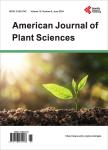Proteomic Analysis through Adventitious Rooting of Pinus radiata Stem Cuttings with Different Rooting Capabilities
Proteomic Analysis through Adventitious Rooting of Pinus radiata Stem Cuttings with Different Rooting Capabilities作者机构:Centro Tecnológico de la Planta Forestal (CTPF) Instituto Forestal (INFOR) Sede Bío-Bío Chile Laboratorio de Cultivo de Tejidos Vegetales Facultad de Ciencias Forestales y Centro de Biotecnología Universidad de Concepción Concepción Chile Laboratories of Adaption Biotechnologies Global Change Research Centre Academy of Sciences of the Czech Republic Brno Czech Republic Plant Physiology Epiphysage Research Group B.O.S. Department Faculty of Biology University of Oviedo Oviedo Spain
出 版 物:《American Journal of Plant Sciences》 (美国植物学期刊(英文))
年 卷 期:2016年第7卷第14期
页 面:1888-1904页
学科分类:0710[理学-生物学] 071001[理学-植物学] 07[理学]
主 题:Pinus radiata Adventitious Rooting Protein Accumulation Aging
摘 要:In forest production systems, vegetative propagation of elite clones through adventitious rooting is a common practice. In Chile, adventitious rooting is the main methodology for vegetative reproduction of Pinus radiata. However, the capability of produce adventitious roots in gymnosperms decreases with aging. While it is true that some efforts have been made to identify markers or/and regulators of the aging process and adventitious rooting, molecular mechanisms that regulate both processes are scarcely known, especially at protein level. This research evaluated qualitative and quantitative changes in protein accumulation during the adventitious rooting process of P. radiata stem cuttings, with different rooting capabilities. Beside, an analysis of morpho-anatomical changes was performed in stem cuttings with high and low rooting capabilities, during the adventitious rooting process. It was observed that juvenile 1-year-old stem cuttings rooted in a 100%, while aged stem cuttings (3-year-old) presented only a 20% of rooting. According to the results of differential protein accumulation, univariate and multivariate analysis indicated that in total, 114 and 89 proteins were differentially accumulated in juvenile and aged cuttings, respectively. Also, identification of such proteins showed the presence of proteins related to cell wall organization and the presence of a protein related with proper distribution of auxin PIN transporter, both key in the new meristem formation process during adventitious rooting.



